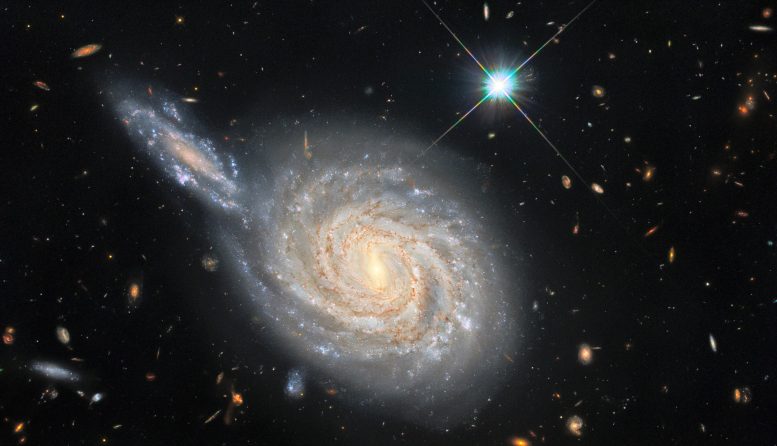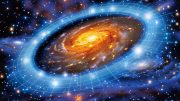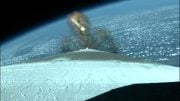
Hubble Space Telescope image of spiral galaxy NGC 105. Credit: ESA/Hubble & NASA, D. Jones, A. Riess et al., Acknowledgement: R. Colombari
NGC 105, imaged by the Hubble Space Telescope, seems to be colliding with a distant galaxy due to a line-of-sight alignment. This galaxy, part of studies on Cepheid variables and supernovae, helps astronomers measure astronomical distances and calibrate methods.
The spiral galaxy NGC 105, which lies roughly 215 million light-years away in the constellation Pisces, is captured in this image from the NASA/ESA Hubble Space Telescope. While it looks like NGC 105 is plunging edge-on into a collision with a neighboring galaxy, this is just the result of the chance alignment of the two objects in the night sky. NGC 105’s elongated neighbor is actually far more distant and remains relatively unknown to astronomers. These deceptive conjunctions are common in astronomy. The stars of constellations, for instance, are at radically different distances from Earth and only seem to form patterns because of the accidental alignment of their component stars.
The Wide Field Camera 3 observations in this image are from a vast collection of Hubble measurements examining nearby galaxies which contain two fascinating astronomical phenomena — Cepheid variables and cataclysmic supernova explosions. Whilst these two phenomena may appear to be unrelated — one is a peculiar class of pulsating stars and the other is the explosion caused by the catastrophic final throes of a massive star’s life — they are both used by astronomers for a very particular purpose: measuring the vast distances to astronomical objects. Both Cepheids and supernovae have very predictable luminosities, meaning that astronomers can tell precisely how bright they are. By measuring how bright they appear when observed from Earth, these “standard candles” can provide reliable distance measurements. NGC 105 contains both supernovae and Cepheid variables, giving astronomers a valuable opportunity to calibrate the two distance measurement techniques against one another.
Astronomers recently carefully analyzed the distances to a sample of galaxies including NGC 105 to measure how fast the Universe is expanding — a value known as the Hubble constant. Their results don’t agree with the predictions of the most widely-accepted cosmological model, and their analysis shows that there is only a 1-in-a-million chance that this discrepancy was caused by measurement errors. This discrepancy between galaxy measurements and cosmological predictions has been a long-standing source of consternation for astronomers, and these recent findings provide persuasive new evidence that something is either wrong or lacking in our standard model of cosmology.









Lot of things explained about ET… UFOs.. Reality is that those things are present and alive.. The pictures displayed and musks seen in many movies are just estimates.. Reality is that no one knows the forms or appearance of ET.. My thoughts are they may be same as us humans.. And whe might differ by the skin color.. Due to different planet.. Whe are not alone in this universe truelly speaking whe search for magical planets orbiting our solar system…. Why do researchers sometimes se exoplanets and fails to detect positive information.. The calculus says..?? 120 light years. That’s how ther will be no human to reach those planets